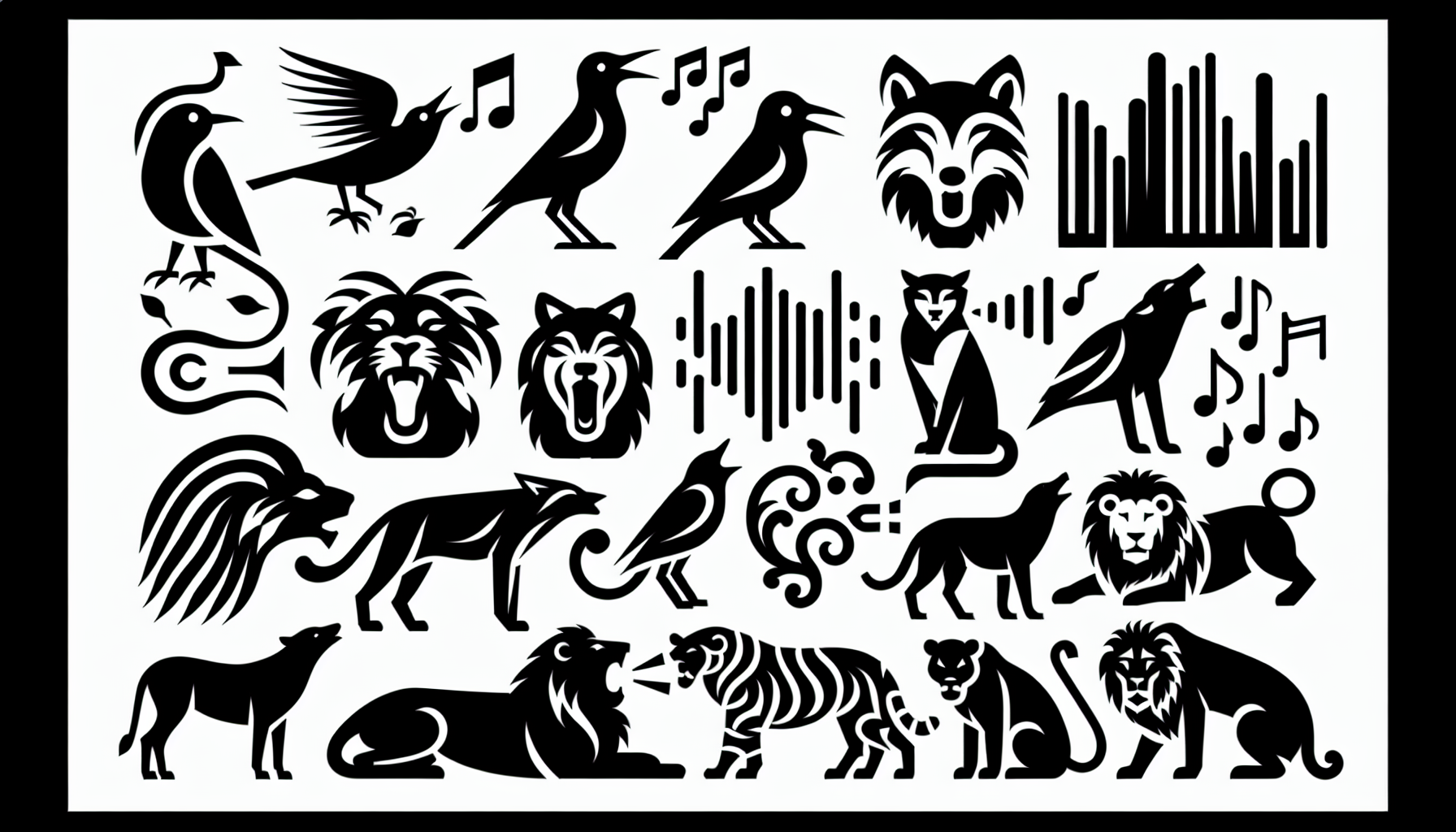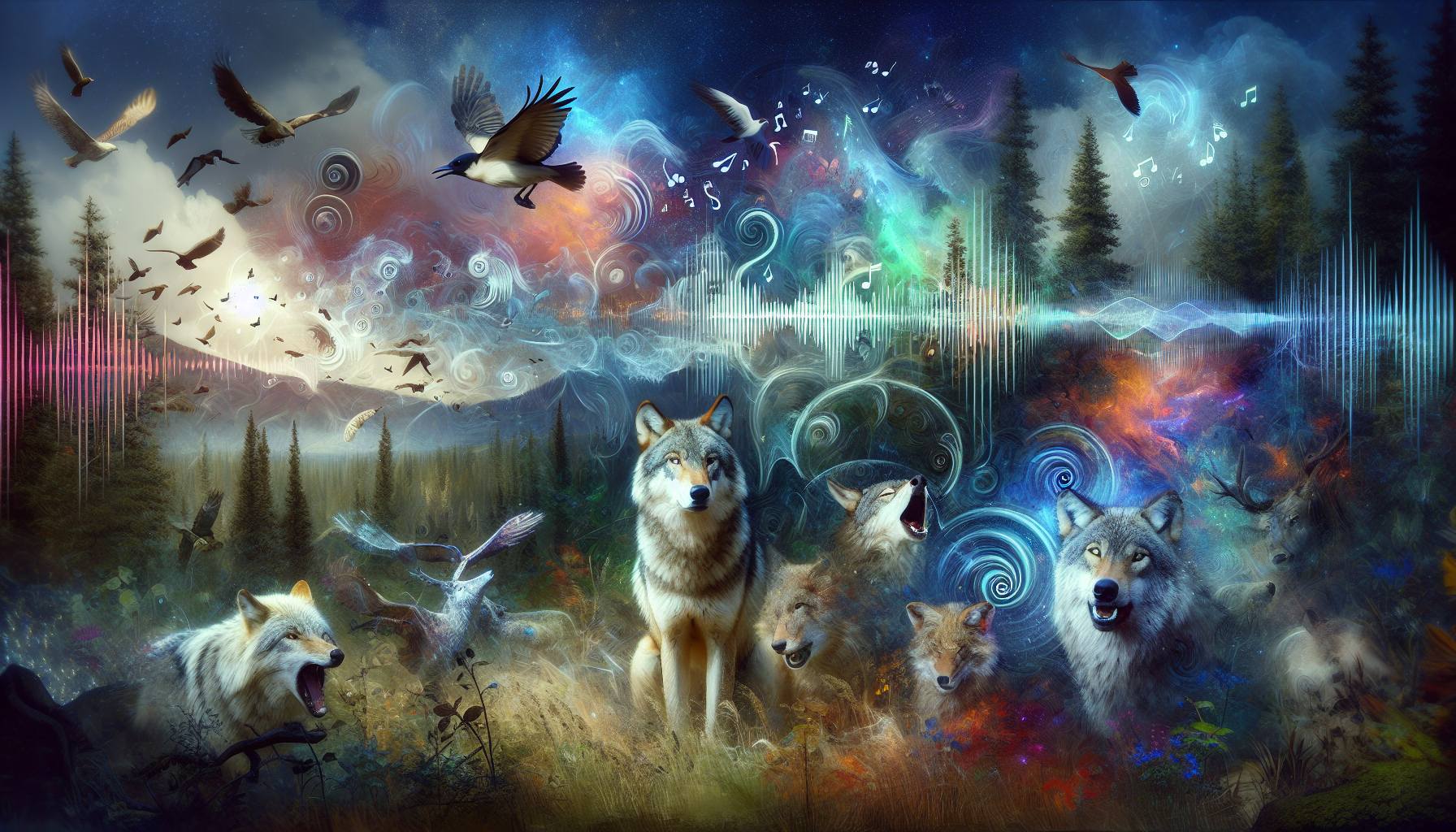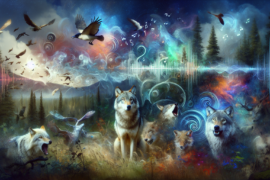So you’ve always wondered what your furry friends are trying to say when they bark, purr, or chirp? Look no further – in this article, we’ll uncover the meanings behind some of the most popular animal vocalizations. From the enthusiastic barks of dogs to the melodious songs of birds, you’ll gain a deeper understanding of the messages these creatures are trying to convey. Get ready to be amazed by the fascinating world of animal communication!

1. Dogs
Dogs are known for their impressive range of vocalizations, each serving a different purpose. From barks to howls, dogs have a variety of sounds that can communicate a wide range of emotions and messages.
1.1 Barks
Barking is perhaps the most well-known vocalization of dogs. It can mean many different things depending on the context and the dog’s individual personality. A sharp, quick bark often functions as an alert, signaling potential danger. On the other hand, a series of rapid barks can indicate excitement or anticipation. Dogs may also bark to express their desire for attention or to communicate frustration.
1.2 Growls
Growling is a vocalization commonly associated with aggression or threat. It is often used as a warning sign to communicate discomfort or a desire for space. However, it’s important to note that not all growls are aggressive in nature. Many dogs also growl during play or to communicate with their littermates. Understanding the context and body language accompanying the growl is crucial to interpreting its meaning.
1.3 Whines
Whining is a high-pitched vocalization that dogs use to express various emotions, often tied to a desire for something. A dog may whine when they are seeking attention, feeling anxious or fearful, or expressing discomfort or pain. Puppies often use whining as a way to communicate their needs and seek comfort from their mother.
1.4 Howls
Howling is a sound often associated with wild canines like wolves, but dogs can also howl. It is a long, drawn-out vocalization that carries over long distances. Dogs may howl to communicate their location, especially when they are separated from their pack or owner. Howling can also be a response to certain sounds, such as sirens or other dogs’ howls, and serve as a form of social bonding.
2. Cats
Cats are known for their unique vocalizations, which can range from gentle meows to fierce hisses. These sounds play a significant role in feline communication and can convey a variety of messages.
2.1 Meows
Meowing is perhaps the most common vocalization made by cats. They use different types of meows to communicate various needs and desires. For instance, a short and soft meow is often a greeting or a request for attention. A long, loud meow, on the other hand, may indicate hunger or a desire to be let outside. Cats are adept at using different tones and pitches to convey their intentions.
2.2 Purrs
Purring is a unique vocalization that is exclusive to felids, and it is often associated with contentment and relaxation. Cats purr when they are comfortable, happy, or even when they are receiving affection. However, cats may also purr when they are exploring or experiencing stress, and their purring can serve as a self-soothing mechanism.
2.3 Hisses
Hissing is a vocalization that cats use as a defensive mechanism when they feel threatened or scared. It is a warning sign that tells potential aggressors to back off. Cats often hiss when they encounter unfamiliar animals, are cornered, or are in pain. It is crucial to give a hissing cat space and avoid any actions that may escalate their fear or anxiety.
2.4 Chirps
Chirping is a unique vocalization that some cats use as a form of communication. It is often associated with excitement or anticipation, especially when observing prey or engaging in play. Cats may make short, rapid chirping sounds when they see birds outside the window or when they are playing with toys that resemble prey. Chirping is thought to be an instinctual behavior inherited from their wild ancestors.
3. Birds
Birds are renowned for their melodic songs, but they also have a diverse range of calls, whistles, and even mimicry abilities. These vocalizations play a crucial role in establishing territories, attracting mates, and communicating with other birds.
3.1 Songs
Bird songs are complex vocalizations produced primarily by male birds during breeding season. Each species has its unique song, which serves to attract potential mates and establish territories. Songs are often characterized by rhythmic patterns, varying pitches, and melodic phrases. They can also convey aggression or territorial warnings to other birds of the same species.
3.2 Calls
Bird calls, unlike songs, are shorter and simpler vocalizations used for a variety of purposes. They can convey alarms, signals of danger, or even contact calls to locate other members of their group. Calls are often used for immediate communication and can be more repetitive and abrupt compared to songs.
3.3 Whistles
Whistles are another form of avian vocalization that birds use to communicate. They are typically sharp, high-pitched sounds that carry over long distances. Whistles can serve as warning calls, territorial displays, or contact calls. Some birds, like certain species of parrots, can be trained to imitate human whistles or melodies.
3.4 Mimicry
Certain bird species are famous for their exceptional mimicry skills. They can mimic the sounds of other birds, animals, or even human-made noises like car alarms or cell phone ringtones. This ability is often used as a form of territory defense or a means to attract mates. Mimicry requires a high level of vocal control and cognitive abilities, making it an impressive behavior within the avian world.
4. Monkeys
Monkeys are highly vocal creatures, using a wide range of calls and vocalizations to communicate within their groups and across their environments.
4.1 Screams
Screams are loud and intense vocalizations produced by monkeys that serve as alarm calls or to express fear and distress. These piercing shrieks can alert other members of the group to potential threats, such as predators or imminent danger. Monkeys can emit screams both as individuals and in a coordinated chorus, creating a powerful and effective warning system.
4.2 Chirps
Chirps are shorter and more rapid vocalizations made by monkeys, often used during social interactions or play. Chirping can signify excitement, initiate play behavior, or act as a friendly greeting among group members. These lively sounds convey positive emotions and strengthen social bonds within monkey communities.
4.3 Grunts
Grunts are low-pitched vocalizations produced by monkeys that serve various purposes. Male monkeys often use grunts as a form of vocal display to attract females or assert dominance within their social hierarchy. Grunts can also express contentment, relaxation, or serve as a vocal expression of satisfaction after a successful activity, such as finding food.
4.4 Pant Hoots
Pant hoots are distinctive vocalizations made by certain species of monkeys, such as chimpanzees and bonobos. These long and rhythmic vocalizations consist of a series of ascending and descending notes that can carry over long distances. Pant hoots are used for a range of purposes, including communication within and between social groups, territorial displays, and inviting others to join in specific activities.

5. Dolphins
Dolphins are highly intelligent marine mammals known for their complex and versatile communication skills. They use a combination of vocalizations and body movements to convey messages and navigate their underwater world.
5.1 Clicks
Clicks are one of the primary vocalizations produced by dolphins. These rapid series of sounds, known as echolocation clicks, serve as a type of sonar system, enabling dolphins to navigate and locate objects underwater. Clicks bounce off underwater objects and return to the dolphin as echoes, providing crucial information about their surroundings and potential prey.
5.2 Whistles
Whistling is another vocalization commonly used by dolphins. These melodic and high-pitched sounds serve as a form of communication within dolphin pods. Whistles can convey various messages, including social bonding, individual identity, or as a means to coordinate group activities. Each dolphin has its unique whistle, similar to human names, allowing individuals to identify and recognize each other.
5.3 Chirps
Chirping is a vocalization often associated with playful interactions among dolphins. It consists of a series of rapid, high-pitched vocalizations that can convey excitement, happiness, or even an invitation to play. Dolphins engage in elaborate social behaviors and use chirps to initiate and maintain social bonds within their pod.
5.4 Body Slaps
Although not a vocalization in the traditional sense, body slaps are a unique form of underwater communication used by dolphins. By forcefully hitting the water’s surface with their tails or fins, dolphins create distinctive percussive sounds that can be heard and felt by others nearby. Body slaps are believed to serve as a way to capture attention, signal dominance, or as a form of shared play among dolphin companions.
6. Whales
Whales are known for their captivating vocalizations, often referred to as “singing.” These complex and melodic sounds are crucial for communication, mating, and maintaining social bonds within their species.
6.1 Songs
Whale songs are perhaps the most famous vocalizations produced by these majestic creatures. These melodic and intricate sequences of sounds can last for several minutes and are often repeated over extended periods. Whale songs are primarily associated with male humpback whales during the breeding season and are believed to attract female whales. These hauntingly beautiful songs can carry over long distances and may contain phrases that change and evolve over time.
6.2 Clicks
Clicks are an essential vocalization used by various whale species for echolocation purposes. Similar to dolphins, whales emit these clicks and listen for echoes, which bounce off objects in the water. Clicks provide crucial information about the environment, potential prey, and can aid in navigation and communication within whale pods.
6.3 Moans
Moans are low-frequency vocalizations produced by whales, often associated with close proximity interactions or social bonding. These deep, melodic sounds can communicate emotional states and intentions. Moans convey a sense of calm, contentment, or excitement and can serve as a way to establish or reinforce social bonds between individual whales.
6.4 Whistles
Whistling is another vocalization used by whales, particularly during social interactions and for individual identification. Whistles can be highly individualized, allowing whales to recognize and communicate with one another. They can also be used as a signal to protect and maintain territory boundaries or to convey emotions such as distress or excitement.
7. Elephants
Elephants are highly intelligent and social creatures that use a diverse range of vocalizations to communicate and navigate their vast habitats.
7.1 Trumpets
Trumpeting is a powerful and resonant vocalization produced by elephants. These loud and trumpeting calls can carry over long distances and serve various purposes. Elephants trumpet to communicate danger, signal excitement, or as a form of greeting between individuals. The intensity and pitch of the trumpet can convey different emotions and intentions.
7.2 Rumbles
Rumbles are low-frequency vocalizations that elephants produce by vibrating their vocal cords. These deep and rumbling sounds can travel through the ground and be detected by other elephants from afar. Elephants use rumbles for long-distance communication, expressing emotions such as curiosity, contentment, or as a means to coordinate group movement.
7.3 Roars
Roaring is a vocalization primarily associated with male elephants during the mating season. These powerful and guttural vocalizations can convey dominance and attract females. Roars are often accompanied by visual displays, such as flapping ears and intimidating postures, creating an imposing presence within the herd.
7.4 Grumbles
Grumbles are soft and low-pitched vocalizations made by elephants, often used for close-range communication within the herd. These gentle rumbles can convey a sense of comfort and reassurance among family members or express desires for grooming, physical contact, or social bonding. Grumbles play an essential role in maintaining social cohesion within elephant communities.
8. Frogs
Frogs are known for their unique and diverse vocalizations, particularly during the breeding season. Each species has its distinctive sound, allowing potential mates to locate each other and establish breeding territories.
8.1 Croaks
Croaking is the quintessential frog sound that most people are familiar with. It is a deep, throaty vocalization produced by male frogs to attract females during the breeding season. Croaks serve as a means of advertisement, signaling the presence of a suitable mating partner and staking out territory boundaries.
8.2 Ribbits
Ribbits are short and repetitive vocalizations commonly associated with frogs. These low-pitched and raspy sounds can vary in intensity and frequency between species. Ribbits are often used in territorial disputes or as a call for communication between neighboring frogs.
8.3 Chirps
Chirping is a vocalization made by specific frog species, such as tree frogs and cricket frogs. These high-pitched sounds are usually produced during courtship and can carry over long distances. Chirping is a way for male frogs to attract females and establish their fitness as potential mates.
8.4 Whistles
Whistling is a vocalization used by certain frog species, characterized by high-pitched, flute-like sounds. These melodious calls are often produced by male frogs to attract females during the breeding season. Whistles can be intricate and complex in their patterns, providing potential mates with information about the caller’s health, strength, and reproductive fitness.
9. Lions
Lions are renowned for their powerful and impressive vocalizations, which play a crucial role in their social structure and communication within the pride.
9.1 Roars
Roaring is perhaps the most iconic vocalization of lions. These powerful and thunderous calls carry over long distances, allowing pride members to communicate and maintain their territories. Roaring is primarily performed by the dominant male lions to claim their dominance and ward off potential intruders. Roars also serve as a means of marking their presence and signaling the boundaries of their territory.
9.2 Grunts
Grunting is a vocalization that lions use during close-range social interactions. It is a more gentle and intimate vocalization, often associated with bonding and affiliative behaviors between pride members. Grunts can convey comfort, reassurance, and serve as a means of maintaining social cohesion within the pride.
9.3 Groans
Groaning is a vocalization that lions use to express various emotions, often tied to stress or discomfort. It is a deep and rumbling sound that can be a response to physical discomfort, such as injury or illness, or as an expression of frustration or irritation. Groans can also occur during mating and courtship rituals.
9.4 Squeaks
Squeaking is a vocalization primarily associated with lion cubs. These high-pitched and nasal sounds are made by the cubs to communicate with their mother and siblings. Squeaking serves as a means of bonding, seeking reassurance, and expressing needs like hunger or discomfort. As cubs grow older, they gradually transition to more mature vocalizations.
10. Wolves
Wolves are known for their haunting and iconic howls, but they also employ a range of vocalizations to communicate and coordinate within their highly social packs.
10.1 Howls
Howling is the most recognizable vocalization of wolves, often heard during the night. Howls serve various purposes, including long-range communication, maintaining social bonds within the pack, and territory defense. Wolves howl to locate each other, coordinate hunting strategies, and warn neighboring packs to stay away from their territory.
10.2 Whines
Whining is a vocalization made by wolves that conveys submissiveness and social bonding. It is often used by lower-ranking pack members to communicate their deference to dominant individuals. Whining can also indicate a desire for attention or serve as a reassurance-seeking behavior within the pack dynamic.
10.3 Growls
Growling is a vocalization associated with aggression and threat, often used during territorial disputes or high-stakes social interactions. Wolves growl to assert dominance, protect resources, or as a warning sign to prevent potential conflicts. Growls are often accompanied by visual displays, such as bared teeth and erect fur, to reinforce their messages.
10.4 Yips
Yipping is a high-pitched and short vocalization commonly emitted by young wolves or during play interactions. It is a means of communication within the pack, particularly during play sessions or when practicing hunting techniques. Yipping serves to strengthen social bonds, signal excitement, and coordinate group activities among young pack members.
In conclusion, vocalizations are a vital part of animal communication. From barks and meows to songs and howls, animals utilize a diverse range of sounds to express their emotions, establish territories, attract mates, and coordinate group activities. Each species has its unique repertoire of vocalizations, highlighting the incredible adaptability and complexity of animal communication systems. By understanding these vocal cues, we can gain insights into the rich and intricate social lives of our animal counterparts.
